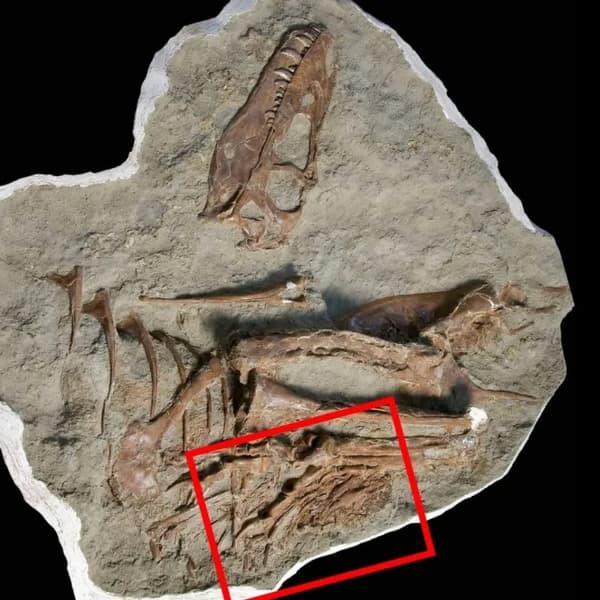We finally know what the tyrannosaurs’ cousins ate. Researchers announce that they have discovered for the first time the fossil of the stomach of a dinosaur close to Tyrannosaurus, in a study published Friday in the scientific journal Science Advances.
It is very rare to find the fossil contents of a dinosaur’s stomach and this is the first time that scientists have discovered the contents of the guts of a Tyrannosaurus, a species that became extinct about 65 million years ago.
The animal’s skeleton was found in Dinosaur Provincial Park in western Canada in 2009, but the remains of its stomach were not immediately detected.
Two legs of small dinosaurs.
The fossil reveals the presence of two baby dinosaur legs in the stomach of the now extinct animal. These dinosaurs belonged to the species Citipes elegans, small feathered herbivores.
“Its last and penultimate meal was these small bird-like dinosaurs, the Citipes, and Tyrannosaurus ate only the hind limbs of each of these prey. There are really no other skeletal remains of these predators in the stomach cavity. They are just the hind legs. ” study co-author Darla Zelenitsky, a paleontologist and associate professor at the University of Calgary in Alberta, Canada, told CNN.
“He must have killed these two Citipes at different times, then tore off their hind legs, ate them and left the rest of the corpses,” estimates the scientist.
“Obviously, this teenager had an appetite for animal thighs,” he says of the young dinosaur.
Discovered by scientists in Canada
Initially, scientists did not notice the presence of fossilized remains of the dinosaur’s last two meals. The discovery was made by members of the Royal Tyrrell Museum in the town of Drumheller, Alberta, in western Canada, when they were examining the fossil in the laboratory.

The small dinosaurs ingested were less than 1 year old at the time they were consumed, according to François Therrien, museum curator of dinosaur paleoecology and co-author of the study.
Tyrannosaurs, also called T-Rex, were the largest known dinosaurs, measuring up to 6 meters high and 13 meters long. The fossil found was that of a Gorgosaurus, a slightly smaller cousin of the Tyrannosaurus, which measured at most 10 meters long.
The Gorgosaurus found weighed, according to researchers, around 350 kg and was 4 meters long at the time of its death. His age is estimated between 5 and 7 years.
Concrete evidence for researchers
This fossil is the first concrete evidence of the eating habits of large dinosaurs like Gorgosaurus, but it matches scientists’ suspicions, according to paleontologist Kat Schroeder.
According to the researchers, the diet of this type of animals probably evolved throughout their lives. “Young tyrannosaurs cannot bite as deeply” as adults, says the researcher, which prevents them from attacking large dinosaurs like Triceratops.
“Teeth can’t tell us much about the diet of extinct animals, so finding stomach contents is like finding irrefutable evidence,” says the scientist.
“Combined with the relative rarity of juvenile tyrannosaur skeletons, this fossil is very significant,” says Kat Schroeder.
Source: BFM TV

